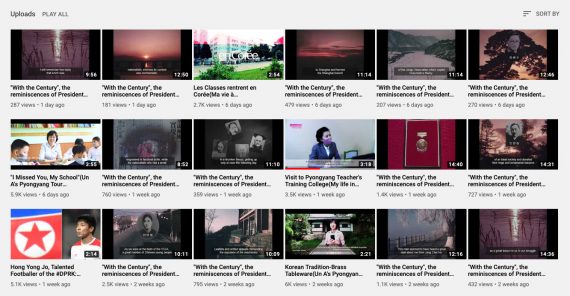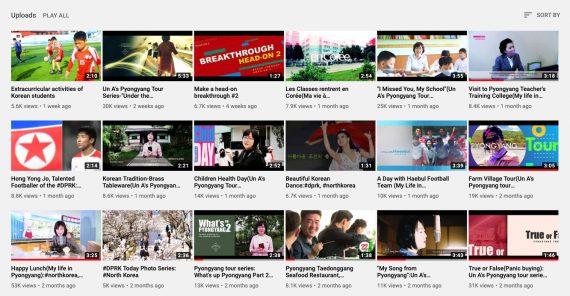One of North Korea’s most popular YouTube channels has quietly removed video documentaries that idolize the life of Kim Il Sung, the father of the modern North Korean state. The surprising move—once considered unthinkable inside the country—is the latest step in an evolving strategy that is bringing North Korea’s overseas propaganda efforts into the 21st century and showing signs of success.
That strategy has seen the creation of several new social media channels that count hundreds of thousands of followers. To get so many followers, the sites have dropped the heavy propaganda of the past and embraced a more contemporary video blogging style that relies on young women to highlight the softer side of life in Pyongyang.
Echo of Truth
In early June, anyone browsing the uploads to the “Echo of Truth” YouTube channel would have seen the “With the Century, Reminiscences of President Kim Il Sung” documentaries mixed in with the more modern content, but now they’re gone from the channel.
In their place, the channel has added a playlist with links to the videos on the North Korean-run “Our Nation School” channel.

The “Echo of Truth” YouTube channel on June 11, 2020.

The “Echo of Truth” YouTube channel on July 15, 2020.
The move appears to be an attempt to raise the profile of the softer content, which is anchored around a series of videos presented by a young North Korean woman identified as “Un A.” Her videos have been considerably more popular: many of the Kim Il Sung videos failed to hit a thousand views while Un A’s videos regularly attract ten times as many clicks.
The videos take viewers along on visits to the Pyongyang Metro, a pizza restaurant, the staff dormitory at the Kim Jong Suk Silk Mill and the Sci-Tech Complex. It’s a world away from the missiles and military parades often seen on TV when North Korea is mentioned. The videos have a much more authentic feel but are obviously state approved and produced—it would be impossible to publish such content independently—and that’s a big change for North Korea.
While other countries have moved to slick 24-hour TV channels and web content to promote themselves, North Korea has remained firmly stuck in the 1980s. It still pumps out 80 hours a day of multilingual shortwave radio broadcasts and publishes monthly magazines that recycle dry domestic news about advances in agriculture, new factories, construction projects and the ever-present updates on the work of the leader and the life of Kim Il Sung and Kim Jong Il. The content simply can’t compete in the saturated media landscape of today, but the appearance of Un A’s videos last year was a sign that things might be changing.
Signs of Change
The first shift happened in May 2017 when the @coldnoodlefan Twitter account was launched. It attempted to deliver North Korean news with a slightly more humane tone and touched on softer issues such as fashion and sports in addition to state propaganda. It also claimed a string of different identities, cataloged by NK News, which concluded it is linked to Sogwang, a North Korean website that is run from a server outside of the country. The “Echo of Truth” YouTube channel (which was originally called “Echo DPRK”) appears to also be run by the same team.
Perhaps after seeing the success of “Echo of Truth,” a second YouTube channel called “New DPRK” launched in October 2019. It also presents a softer side to North Korea and has its own hosts who take viewers to places such as a Pyongyang burger restaurant, the stamp museum, a supermarket and a horse-riding club. Like “Echo of Truth,” its videos regularly reach into the tens of thousands of views but unlike its sister channel, “New DPRK” videos are presented only in Korean with English subtitles.

The “New DPRK” video channel on YouTube.
In total, “Echo of Truth” has racked up 1.5 million views on YouTube and “New DPRK” is approaching 600,000 views. Both are impressive but pale in comparison to North Korea’s recent success on Chinese social networks.
New DPRK
The most popular of North Korea’s Chinese accounts is “New DPRK,” which is operated by the team behind the YouTube channel of the same name. But while it has just over 12,000 subscribers on YouTube, its audience is considerably higher on Chinese social media sites. It has an impressive 533,000 followers on Weibo and 65,000 followers on video-sharing site Bilibili. It also publishes on news app Toutiao and WeChat.
Since 2018, “New DPRK” has been posting videos featuring daily life in North Korea. Late last year it launched the same video blog as its YouTube sister channel called “Walk into DPRK” in which a young North Korean woman visited places in Pyongyang, such as a hamburger restaurant, a mobile phone shop and a supermarket.

“New DPRK” “Walk into DPRK” videos on China’s Bilibili.
The video blog proved popular and in April this year added a new character: A 7-year old girl named Ri Su Jin. In her first video, Ri is seen playing the piano at a school sports event and washing her hands with her mother. Subsequent videos have followed with each attracting over 20,000 views each time. One featuring Ri preparing for the new school year has been watched over 370,000 times on Weibo.

Seven-year-old Ri Su Jin in a video on China’s Bilibili.
The operation is drawing a significant audience in China and North Korea is using that reach to push a second agenda. Alongside the slice-of-life videos, the Weibo account posts daily news articles and commentary regarding social issues and problems in mainly Western countries. At present, many of the posts highlight racism in the United States but in the last few days, the account has also covered climate change, attacks on US troops in Iraq, online child pornography in South Korea and child neglect in Japan.
I Take You to Koryo
A second North Korean account on Weibo, called “I Take You to Koryo,” appears to be run by the same group behind the @coldnoodlefan Twitter account and “Echo of Truth” YouTube channel. Since last November, it started carrying the Un A series of Pyongyang lifestyle videos with Chinese subtitles.
When they debuted, a Weibo user asked if the video was made by North Korean authorities. The account replied: “It’s original. I saw the videos had a good effect on foreign social media platforms like YouTube, so I’m uploading them to Weibo as well.”
Like the @coldnoodlefan Twitter account, the identity of the organization behind the Weibo account is unclear. It claims to be run as a personal blog but that’s clearly not possible under North Korea’s Internet and information control regime.
In April this year, the first Chinese language video from Un A appeared. It was a version of “What’s up Pyongyang? Covid19 situation in DPRK,” and it attracted 170,000 views—about double the number that watched it in English on YouTube. The latest video, a tour of the Pyongyang Metro, has so far attracted 30,000 views on YouTube and 337,000 views on Weibo.

Un A takes viewers on a trip to the Pyongyang Metro on Weibo.
The New and the Old
Together, the videos point to an evolution in the way North Korea practices propaganda and outreach to audiences overseas. At a minimum, the teams behind these accounts have realized that simply translating domestic propaganda into foreign languages doesn’t hold any interest for the rest of the world. It also perhaps shows awareness that the image many people overseas have of the country is one of military parades, missile tests and bombastic TV news anchors. The new Internet videos are the complete opposite. At least for now, the videos are tied to several North Korean propaganda sites that are based overseas: Sogwang is run from a Russian server and DPRK Today is run from a server in Germany. The teams behind both sites are likely based in China.
Still, some North Korean propaganda remains stuck in the past. There hasn’t been any change in the methods used by sites based in Pyongyang, such as the KCNA news agency or Rodong Sinmun newspaper. And Voice of Korea continues to broadcast translated domestic news, propaganda songs and readings from Kim Il Sung’s memoirs to a global audience of likely no more than a few hundred people.
This story first appeared on 38North.




